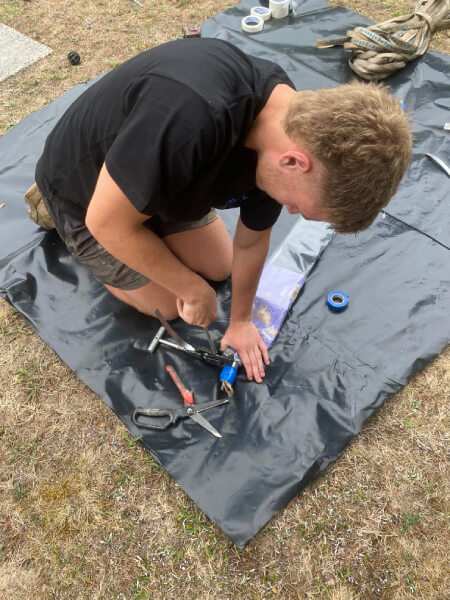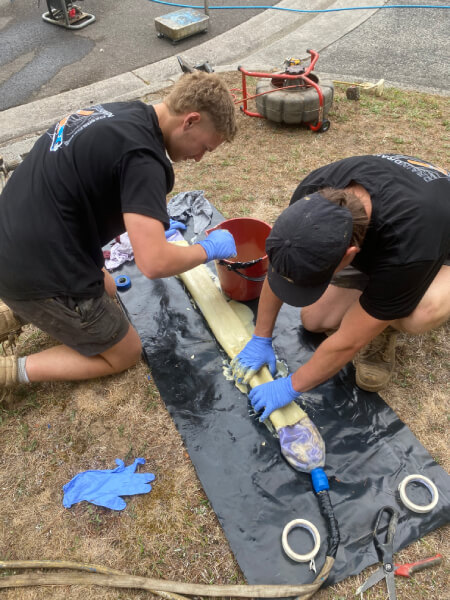-
Call Us 1300-663-569
-
Email Us office@drainfixers.com.au
-
Price MatchGuaranteed!
Before sewer pipe relining became accessible to Australian property owners and strata managers, plumbers had to dig up broken sewers to fix damaged pipes and prevent ongoing blockages. Unfortunately, trench pipe digging methods can be disruptive, damaging to surrounding environments, and expensive. Whilst digging up pipes sometimes can’t be avoided, for the most part, pipes can be repaired with a faster, simpler and cheaper method—pipe relining (or ‘no dig’ pipe repair)
In this article, we’ll look at why sewer pipe relining is becoming the preferred method for fixing broken drainage pipes. We’ll also investigate the notable benefits of no-dig pipe repair and why you should consider sewer pipe relining for your residential, commercial, or strata property if the need arises.
But first, let’s look at sewer pipe relining and how it differs from traditional drain repair.
WHAT IS SEWER PIPE RELINING?
Sewer pipe relining (trenchless pipe repair) uses cutting-edge technology to identify issues within your drains and provide a permanent repair, generally within a single day. Rather than digging up and replacing an old pipe with a new one, a structural liner is used, which is formed and cured in the shape of your existing drain. Effectively, a new pipe 6-8 times stronger than PVC is installed inside the old one without digging.
The sewer pipe relining process we follow at Drain Fixers goes like this:
- We feed a high-definition CCTV camera into the drain to locate and identify any faults or issues and pinpoint the cause and location of any damage.
- If there’s an obstruction in the sewer pipe, such as a tree root or star picket, we use diamond-head robotic cutters to remove them. (In some cases, obstructions can’t be cleared, or the pipe may have collapsed, and we may need to dig.)
- We use a high-pressure water jet to clean and prepare the pipe for relining.
- We prepare a new structural pipe liner by filling it with two-part epoxy resin, inserting a deflated bladder into the liner, and then inserting the liner and bladder into the damaged pipe. Once in position, the bladder expands the liner to form the shape of the new pipe (a new seamless pipe inside the old one).
- The resin cures quickly to form a permanent replacement sewer pipe. The bladder is removed, and the new pipe section is checked using CCTV to ensure a perfect fix.
Overall, this process is fast, effective, and long-lasting. Because there’s no digging, minimal disruption and damage to the surrounding environment are caused. Let’s look more closely at the benefits of sewer pipe relining.

THE BENEFITS OF SEWER PIPE RELINING
The sewer pipe relining method has many advantages over trench-digging drain repair. These include environmental benefits, cost benefits, and a massive reduction in inconvenience.
ENVIRONMENTAL BENEFITS OF ‘NO DIG’ DRAIN PIPE RELINING
There are many environmental benefits of ‘no dig’ sewer pipe relining.
Reduced soil contamination
Fixing a damaged sewer pipe quickly is important to limit wastewater contamination in the soil surrounding your property. Wastewater poses obvious health risks, not to mention unpleasant odours, so the sooner the problem is addressed, the better. Sewer pipe relining can be done quickly, with a new pipe available within hours. Digging methods take longer, resulting in more wastewater leaching into the soil.
Reduced damage to gardens
A second benefit to sewer pipe relining is less damage to the landscape. When you dig up a pipe on a property, plants often need to be removed as part of the process. This results in damage to gardens that may have taken years to establish and potentially damage to habitats for native fauna. Sewer pipe relining does not require any removal of flora.
Reduced erosion
When you dig, you disturb the soil, resulting in soil erosion on your property. Eroded soil turns into problematic dust around your home, can be washed into drains and pollutes local waterways, which is far from ideal.
No need for heavy machinery
Finally, excavating drains may require heavy machinery, which uses fuel. To reduce energy consumption, it’s preferable to opt for pipe relining.
Other ways to lessen the environmental impact of your home
Another option that can be of environmental benefit to your home is to retrofit existing windows with double glazed windows.
COST BENEFITS TO DRAIN PIPE RELINING
Various costs accompany traditional pipe digging methods, making the process more expensive than sewer pipe relining. Here is a rundown:
- Labour costs: Digging up drains often requires more than one worker. Depending on the location of the repair and how much pipe needs to be repaired or replaced, it may take many hours, if not days, to fix the issue. This all adds up to significant labour costs.
- Cost of machinery: If heavy machinery is required to dig up a drain on your property, this will add to the cost.
- Cost of new piping: It’s difficult to say how much it costs, as it depends on how much pipe needs replacing and what type of pipe material you need (certain pipe materials are more expensive than others). The type and size of the replacement pipe your plumber recommends will depend on your current drain and the pipe's location on your property. There will also be a cost for associated pipe fittings.
- Cost of a permit: Council permits are required for significant excavation work or if you need to dig in areas that may impact neighbouring properties or cause a hazard to the general public during a dig. There is always a cost involved and a waiting time for the permit to come through.
- Repair costs: Digging causes damage, whether to landscaping and gardens outside your building or flooring and walls within your building. Repairing this damage will cost money.
- Accommodation costs: The buildings may not be habitable during excavation if significant pipe work is required beneath your home or underneath units and businesses on strata properties. Temporary accommodation costs may be involved, and this cost may be high if multiple residents are impacted.
WHY NO-DIG DRAIN REPAIR METHODS COST LESS
- Reduced labour costs: Sewer pipe relining takes far less time than digging up drains. Most repairs can be completed within a single day, reducing overall labour costs.
- No heavy machinery involved: Drain pipe relining doesn’t require heavy machinery, which rules out the cost of machine hire and fuel.
- No new piping required: Rather than spending on replacement piping, the new piping is created within the old piping. This saves you money on new, expensive pipes and pipe fittings. In addition, the new, cured piping operates effectively and will last much longer than traditional repairs.
- No permit costs: Because nothing is being dug up, there is usually no need for costly council permits.
- No repair costs: Again, no damage is being done to your landscape, flooring, etc., so no costly repair/replacement work is needed.
- No accommodation costs: Nobody needs to vacate a property during sewer pipe relining work. At most, residents may be asked to keep a stopper/plug in the drain hole of sinks so vapours don’t enter the building as the resin cures within the pipes.

SEWER PIPE RELINING - LONGLASTING DRAIN PIPES
Pipe relining is not a "one brand fits all" approach. Different liners and resins are required for various scenarios. Some pipelines need strength, while others require flexibility or structural integrity. After thoroughly inspecting your drains, we carefully select the best liner and resin tailored to your specific needs to achieve a permanent repair solution.
As a provider of high-quality materials and expert installation, we exclusively use styrene-free, non-toxic resins. All relining products are Watermarked for use under Australian Plumbing Standards. Under normal use, relined drain pipes can be expected to last far longer than traditional PVC. Manufacturer warranties range from 10 to 50 years.
SEWER PIPE RELINING - REDUCED DISRUPTION
Digging up sewer pipes can disrupt those living or working on a property. It creates a lot of noise and dust, and spaces may not be habitable while work is underway. Sewer pipe relining causes far less disruption. People can usually remain on the property while work is being carried out, and modern resins take little time to cure, so drains can typically be used as soon as the job is complete.
When Digging is Required
Sometimes, digging up the damaged sewer may be necessary rather than relining it.
- There are badly misaligned or detached joins in the pipes
- The drain has already collapsed, so drain relining can’t be executed
- The sewer pipe is falling the wrong way (water’s running backwards)
- There’s no downstream access available to insert the liner
- A solid obstruction inside the pipe cannot be removed using traditional methods
In these situations, manual replacement of the damaged sections of the pipe may be required. Fortunately, the experts at Drain Fixers provide Drain Replacement and Pipe Relining services. After assessing your drain using CCTV Drain Camera Inspection, we can recommend the best solution for a permanent repair.
In many cases, relining is the best choice, as it’s quicker, easier, and more cost-effective, but if that’s not possible, we’ll dig it up and replace it with as little disturbance as possible.
